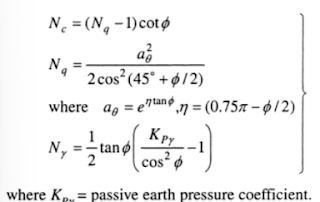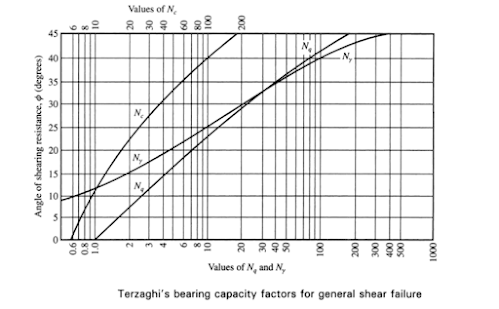Search This Blog
Most Popular
What is Development Length (Ld) in Construction?
August 14, 2025
Categories
- Building Construction (87)
- Building Materials (85)
- Columns (2)
- Concrete Beam (3)
- Concrete Construction Techniques (6)
- Concrete Mix Design (14)
- Concrete Repair (14)
- Concrete Slab (11)
- Construction Equipment (17)
- Construction News (7)
- Design of Structures (18)
- Engineering Drawing (1)
- Estimation (3)
- Geotechnical engineering (26)
- Highway Engineering (11)
- Innovations (34)
- Material Testing (11)
- Matrix Analysis of Structures (2)
- Mechanical Engineering (3)
- Strength of Materials (2)
- Structural Analysis (13)
- Structural Design (24)
- Structures (17)
- Transportation Engineering (9)
Terzaghi's Equation: Soil Bearing Capacity for Foundations
Team Prodyogi
March 02, 2022
Terzaghi (1943) developed a rational bearing capacity equation for strip footing, by assuming the bearing capacity failure of the foundation in general shear mode. The theory was an extension of Prandtl's theory (1921).
 |
| Fig.1. General Shear Failure Mode for Strip Footing - Terzaghi's Theory Assumed Bearing Capacity Failure |
The assumptions and failure surface assumed for deriving the bearing capacity equation are explained in this article.
Assumptions in Terzaghi's Bearing Capacity Equation
- The soil is semi-infinite, homogeneous, and isotropic.
- The problem is studied in two-dimensional.
- The base of the footing is rough.
- The ground surface is horizontal.
- The failure is studied as a general shear failure.
- The load acting on the footing is vertical and symmetrical.
- The overburden pressure at the foundation level is equivalent to the surcharge load calculated as qo = γDf, Where γ is the effective unit weight of the soil, and Df is the depth of the foundation less than the width of the foundation.
- The principle of superposition can be applied.
- Coulomb law, i.e. σ = C + σ tan ф; is employed.
Read ON
Terzaghi's Bearing Capacity Equation
The Terzaghi's bearing capacity equation is given by:
qu = CNc + γ1DfNq + 0.5Bγ2Nγ
In the above equation, and as per Fig.1,
- qu= Ultimate Bearing Capacity of the soil
- C= Cohesion
- γ1,γ2= Unit weight of the soil above and below the footing level ( Fig.1)
- Nc,Nq, Nγ= Bearing capacity factors that are a function of friction angle
- Df= Depth of the foundation below the ground level (Fig.1)
In the above equation:
- CNc = Contribution of cohesion
- γ1DfNq = Frictional contribution of overburden pressure or surcharge
- 0.5Bγ2Nγ = Frictional contribution of self-weight of soil in the failure zone
The bearing capacity factors Nc,Nq,Nγ are determined by the following equations:
Based on the cross-section of the foundation square, rectangular or circular, the values vary and respective equations can be determined. You can read this here Bearing Capacity Equations for Square, Rectangular, and Circular Strip Footings.
Terzaghi's Bearing Capacity Theory
Terzaghi's bearing capacity equation was derived by assuming a general shear failure of soil under the action of an ultimate load per unit area (qu) as shown in Fig.2. Under the action of this load, failure surfaces are formed below the footing, which divides the soil into three zones of plastic equilibrium. The three zones are:
- Zone 1 : Elastic Equilibrium
- Zone II : Radial Shear
- Zone III: Rankine Passive State
The sinking of Zone 1 creates two zones of plastic equilibrium, i.e. Zone II and Zone III, on either side of the footing as shown in Fig.2. Zone II is the radial shear zone whose remote boundaries bd and af meet the horizontal surface at angles ( 45 - Φ/2), whereas Zone III is a passive Rankine zone.
The boundaries de and fg of these zones are straight lines and they meet the surfaces at angles ( 45 - Φ/2). The curved parts cd and cf in Zone II are parts of logarithmic spirals whose centers are located at b and a respectively. Given Φ is the angle of shearing resistance.
Most Visited
Soil Sampling Methods| Undisturbed and Disturbed Samples
November 08, 2023
Boring Methods for Soil Exploration
November 02, 2023
What are Infiltration Wells?
April 15, 2024
Steel Column Connected to Concrete Masonry Wall
October 11, 2017
How to Choose Good Quality Aggregates for Construction?
August 10, 2021
Terzaghi's Equation: Soil Bearing Capacity for Foundations
March 02, 2022
Structure of Timber |Macrostructure and Microstructure
March 22, 2024
Search This Blog
MUST READ
What is PERT? Objectives, Pros & Cons
September 10, 2017
Terzaghi's Equation: Soil Bearing Capacity for Foundations
March 02, 2022
Contact Form
Footer Menu Widget
Created By SoraTemplates | Distributed By Gooyaabi Templates




0 Comments
Commenting Spam Links Are Against Policies